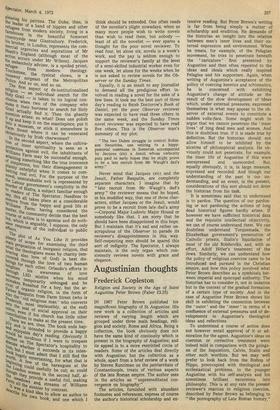Augustinian thoughts
Frederick Copleston
Religion and Society in the Age of Saint Augustine Peter Brown (Faber £3.25) IN 1967 Peter Brown published his magnificent biography of St Augustine. His new work is a collection of articles and reviews of varying length which are grouped under three main headings, religion and society, Rome and Africa. Being a collection, the book obviously does not have the same kind of continuity which is present in the biography of Augustine; and its appeal is to a more restricted circle of readers. Some of the articles deal directly with Augustine; but the collection as a whole, apart from a brief review. of a work by Steven Runciman on the patriarchate of Constantinople, treats of various aspects of the late Roman empire. The author sees in the articles an "unpremeditated convergence on biography."
The articles, furnished with abundant footnotes and references, express of course the author's historical scholarship and ex
scholarship and erudition. He demands of the historian an insight into the relation between men's inner lives and their ex ternal expression and environment. When he treats, for example, of the Pelagian movement, he tries to penetrate beneath the ' caricature ' first presented by Augustine and then often repeated to the ideas and ideals which really inspired
Pelagius and his supporters. Again, when writing of Augustine's acceptance of the policy of coercing heretics and schismatics, he is concerned with exhibiting Augustine's change of attitude as the result of the slow development of 'ideas which, under external pressures, expressed themselves in what may appear to the observer of external events to constitute a sudden volte-face. Some might wish to argue that we cannot penetrate the 'inner lives' of long dead men and women. And this is doubtless true. if it is made true by definition. But the historian should not allow himself to be inhibited by the niceties of philosophical analysis. He obviously could not penetrate, for example, the inner life of Augustine if this were unexpressed and unrecorded. But, equally obviously, it is, in large measure, expressed and recorded. And though our understanding of the past is our understanding, and an event, in the present, considerations of this sort should not deter the historian from his task.
It is sometimes said that to understand is to pardon. The question of our pardoning or not pardoning the actions of long dead historical figures hardly arises. If however we have sufficient historical data and the requisite intellectual objectivity, we can of course understand them. We can doubtless understand Torquemada, the Elizabethan government's persecution of Catholic priests, Stalin's liquidation of most of the old Bolsheviks, and, with an effort, Adolf Hitler's treatment of the Jews. Similarly, we can understand how the policy of religious coercion came to be introduced and pursued in the Christian empire, and how this policy involved what Peter Brown describes as a symbiosis between imperial and episcopal authority. The historian has to consider it, not in isolation but in the context of the gradual formation of a certain type of society. And in the case of Augustine Peter Brown shows his skill in exhibiting the connection between the ' outer' and the 'inner' in terms of a confluence of external pressures and of developments in Augustine's theological ideas and reflections.
To understand a course of action does not however entail approval of it or admiration for the agent. Augustine's ideas on coercion or corrective treatment were indeed mild in comparison with the goingson of the Inquisitors, Calvin, Stalin and other such worthies. But we may well prefer to look back from the Bishop of Hippo, preoccupied with theological and ecclesiastical problems. to the younger Augustine with his self-analysis and his sometimes brilliant excursions into philosophy. This is at any rate the present reviewer's reaction to religious coercion, described by Peter Brown as belonging to "the pornography of Late Roman history," and to Augustine's endorsement of it. As however the author insists, we have to see this particular piece of ' pornography' in the context of "the slow emergence of a society ever more sharply contoured by religious belief." And Peter Brown skilfully relates Augustine's stand in this matter to his reflections on the relation between pre destination and human freedom. The understanding can leap over the centuries. Our emotive reactions are likely to be governed by our membership of a pluralist society, by an acceptance of its values and by its influence on our theological outlook, if, that is to say, we have one. What I mean is that actual experience of a pluralist society shows us that uniformity of religious belief is not required for social solidarity, and that this fact inclines us to recognise more easily in our theological beliefs, if we have any, those elements which are hostile to the idea of religious coercion. We can then both understand and reject the policy which has been such an ugly feature of the history of religion and which has of course taken secularised forms.











































 Previous page
Previous page